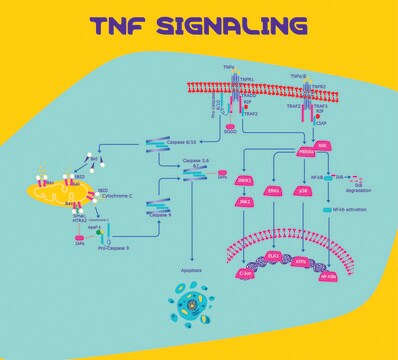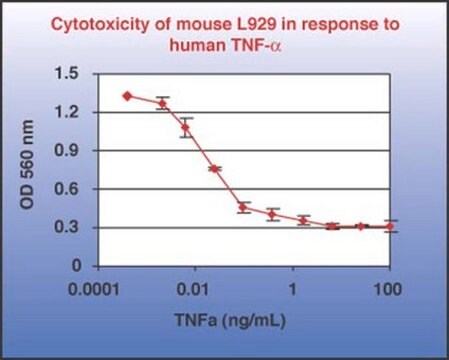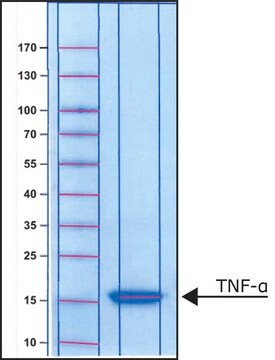Key Documents
11088939001
Roche
Tumor Necrosis Factor-α, human (hTNF-α)
recombinant (yeast)
Synonim(y):
hTNF, human necrosis factor
About This Item
Polecane produkty
pochodzenie biologiczne
human
Poziom jakości
rekombinowane
expressed in yeast
Próba
≥95% (SDS-PAGE)
Postać
solution
siła działania
≤0.01 ng/mL EC50
aktywność właściwa
>1*10^8 U/mg
masa cząsteczkowa
17,000 Da
opakowanie
pkg of 1,000,000 U (10 μg, 1ml)
producent / nazwa handlowa
Roche
warunki przechowywania
avoid repeated freeze/thaw cycles
zanieczyszczenia
<0.1 EU/μgtested (LAL test)
numer dostępu UniProt
temp. przechowywania
−20°C
informacje o genach
human ... TNF(7124)
Opis ogólny
Specyficzność
Zastosowanie
- Shows cytolytic and/or cytostatic activity on a variety of transformed cell lines.
- Has activating and growth stimulating activities on a variety of normal cells.
- Has antiviral activity on many cell types in vitro.
- Can cause tumor necrosis of certain tumors in vivo.
Działania biochem./fizjol.
Jakość
Endotoxin level: <0.1 EU/μg (LAL-test), <10 EU/ml (LAL-test)
Sekwencja
Definicja jednostki
Postać fizyczna
Uwaga dotycząca przygotowania
For complete cell lysis of sensitive cell lines about 1 ng/ml is recommended.
Working solution: Dilute the concentrated hTNF-α solution (10 μg/ml) with PBS or culture medium containing BSA (or HSA), 1 mg/ml (0.1%) or serum 1 to 10%.
Storage conditions (working solution): -15 to -25 °C
It is recommended to store the solution in aliquots at -15 to -25 °C.
Note: Avoid repeated freezing and thawing.
Inne uwagi
Kod klasy składowania
12 - Non Combustible Liquids
Klasa zagrożenia wodnego (WGK)
nwg
Temperatura zapłonu (°F)
does not flash
Temperatura zapłonu (°C)
does not flash
Certyfikaty analizy (CoA)
Poszukaj Certyfikaty analizy (CoA), wpisując numer partii/serii produktów. Numery serii i partii można znaleźć na etykiecie produktu po słowach „seria” lub „partia”.
Masz już ten produkt?
Dokumenty związane z niedawno zakupionymi produktami zostały zamieszczone w Bibliotece dokumentów.
Nasz zespół naukowców ma doświadczenie we wszystkich obszarach badań, w tym w naukach przyrodniczych, materiałoznawstwie, syntezie chemicznej, chromatografii, analityce i wielu innych dziedzinach.
Skontaktuj się z zespołem ds. pomocy technicznej







